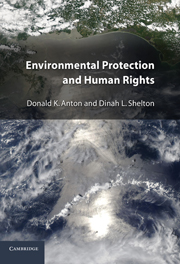Book contents
- Frontmatter
- Contents
- Acknowledgments
- Abbreviations
- Table of Cases
- 1 Law and the Environment
- 2 The Environment as a Human Rights Issue
- 3 An Introduction to Human Rights Origins and Theory
- 4 The International Protection of Human Rights
- 5 International Human Rights Institutions and Procedures
- 6 Procedural Human Rights and the Environment
- 7 Substantive Human Rights and the Environment
- 8 Indigenous Peoples, Rights, and the Environment
- 9 Humanitarian Crises: Armed Conflicts and Other Disasters
- 10 Environmental Rights and International Finance: The World Bank Example
- 11 Human Rights, the Environment, and Corporate Accountability
- Index
7 - Substantive Human Rights and the Environment
Published online by Cambridge University Press: 05 June 2012
- Frontmatter
- Contents
- Acknowledgments
- Abbreviations
- Table of Cases
- 1 Law and the Environment
- 2 The Environment as a Human Rights Issue
- 3 An Introduction to Human Rights Origins and Theory
- 4 The International Protection of Human Rights
- 5 International Human Rights Institutions and Procedures
- 6 Procedural Human Rights and the Environment
- 7 Substantive Human Rights and the Environment
- 8 Indigenous Peoples, Rights, and the Environment
- 9 Humanitarian Crises: Armed Conflicts and Other Disasters
- 10 Environmental Rights and International Finance: The World Bank Example
- 11 Human Rights, the Environment, and Corporate Accountability
- Index
Summary
Introduction
During the nearly four decades since the Stockholm Conference, courts enforcing national and international human rights guarantees have concluded that a safe and healthy environment is a prerequisite to the effective enjoyment of many human rights. Tribunals have come to view environmental protection as essential for the equal enjoyment of, in particular, the rights to life, health, adequate standard of living, home life, and property.
In addition and perhaps in recognition of the linkages, lawmakers in many countries have drafted constitutional and legislative provisions setting forth the right to an environment of a specified quality, such as healthy, safe, secure, clean, or ecologically sound. See Barry E. Hill, Steve Wolfson, & Nicholas Targ, Human Rights and the Environment: A Synopsis and Some Predictions, 16 Geo. Int'l Envtl. L. Rev. 359, 381–88 (2004) (examining the Constitutions of India, Philippines, Columbia, and Chile); Carl Bruch, Wole Coker, & Chris VanArsdale, Constitutional Environmental Law: Giving Force to Fundamental Principles in Africa, 26 Colum. J. Envtl. L. 131 (2001); Edwin Egede, Human Rights and the Environment: Is There a Legally Enforceable Right of a Clean and Healthy Environment for Peoples of the Niger Delta Under the Framework of the 1999 Constitution of the Federal Republic of Niger?, 19 Sri Lanka J. Int'l L. 51 (2007); Jan Glazewski, Environment, Human Rights, and the New South African Constitution, 7 S. Afr. J. on Hum. Rts. 167 (1991). Two regional human rights treaties also expressly guarantee this right.
- Type
- Chapter
- Information
- Environmental Protection and Human Rights , pp. 436 - 544Publisher: Cambridge University PressPrint publication year: 2011
- 2
- Cited by

